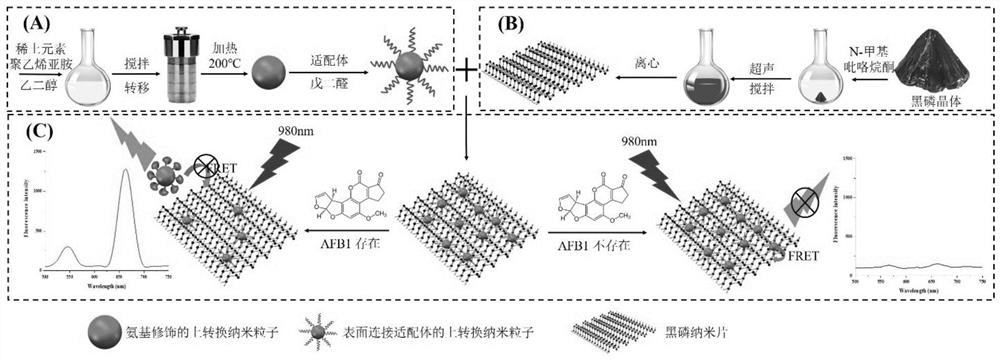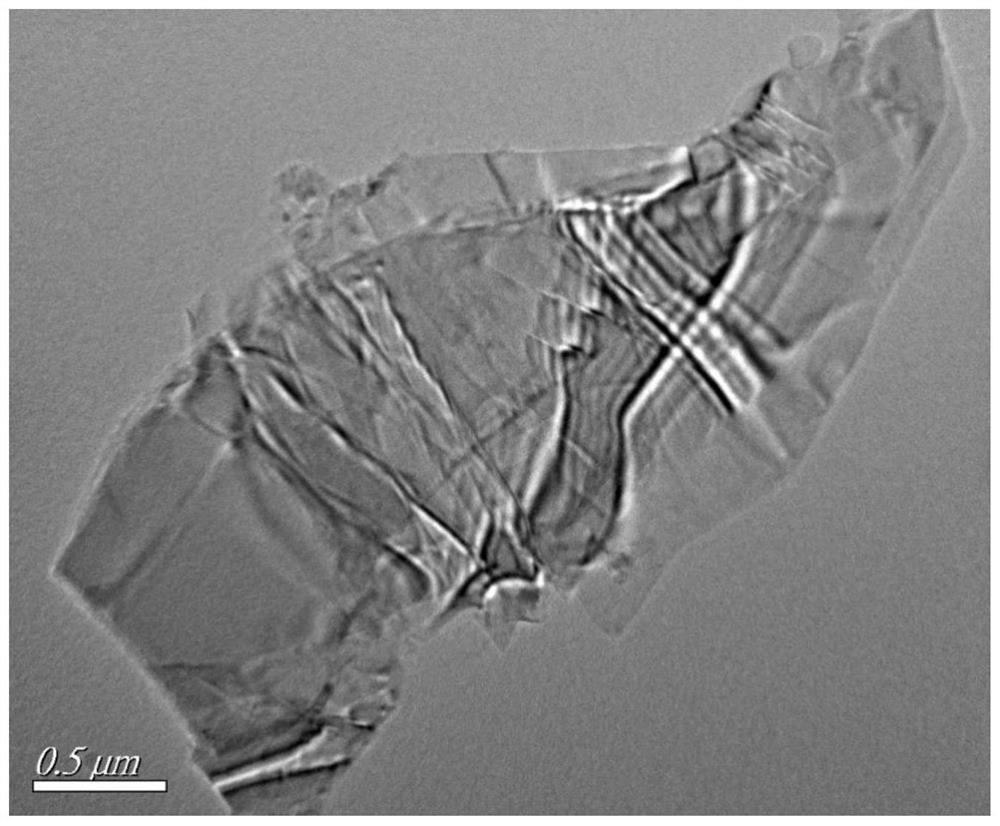An aptamer sensor based on upconversion and black phosphorus nanosheets for the detection of aflatoxin b1
A technique for the detection of aflatoxin and aflatoxin B1, which is applied in the field of detection of aflatoxin B1, and can solve problems such as the inability to meet the requirements of rapid and high-sensitivity detection of AFB1 content, the low detection accuracy and sensitivity of AFB1, and the inability to achieve specific detection of AFB1. Achieve the effects of eliminating background fluorescence and interference from other molecules, good practical prospects, and ensuring food security
- Summary
- Abstract
- Description
- Claims
- Application Information
AI Technical Summary
Problems solved by technology
Method used
Image
Examples
Embodiment 1
[0046] Embodiment 1 Detection of aflatoxin B1 content in peanut oil
[0047] A method for detecting aflatoxin B1 based on an aptamer sensor based on upconversion and black phosphorus nanosheets, comprising the following steps:
[0048] Step 1, preparation of amino functionalized up-conversion nanomaterials: accurately weigh 0.2366g yttrium chloride hexahydrate, 0.0775g ytterbium chloride hexahydrate, 0.0076g erbium chloride hexahydrate, 0.1461g sodium chloride and 0.1852g fluoride Ammonium was added to 15 mL of ethylene glycol solution, dissolved by ultrasonic for 10 min, transferred to a 100 mL round-bottomed flask with magnetic stirring for 30 min, and mixed evenly; 0.2 g of polyethyleneimine was added to the mixed solution under light-proof conditions and fully stirred for 10 min; The uniformly mixed solution was transferred to a polytetrafluoroethylene-lined autoclave, and reacted at 200 °C for 12 h to obtain a reaction product; after cooling, the reaction product was prec...
Embodiment 2
[0062] Example 2 Detection of aflatoxin B1 content in wheat
[0063] A method for detecting aflatoxin B1 based on an aptamer sensor based on upconversion and black phosphorus nanosheets, comprising the following steps:
[0064] Step 1, preparation of amino functionalized up-conversion nanomaterials: accurately weigh 0.2366g yttrium chloride hexahydrate, 0.0775g ytterbium chloride hexahydrate, 0.0076g erbium chloride hexahydrate, 0.1461g sodium chloride and 0.1852g fluoride Ammonium was added to 15 mL of ethylene glycol solution, dissolved by ultrasonic for 15 min, transferred to a 100 mL round-bottomed flask with magnetic stirring for 40 min, and mixed evenly; under light-proof conditions, 0.2 g of polyethyleneimine was added to the mixed solution and fully stirred for 10 min; The uniformly mixed solution was transferred to a polytetrafluoroethylene-lined autoclave, and reacted at 180 °C for 8 hours to obtain the reaction product; after cooling, the reaction product was precip...
Embodiment 3
[0072] Example 3 Detection of aflatoxin B1 content in peanuts
[0073] A method for detecting aflatoxin B1 based on an aptamer sensor based on upconversion and black phosphorus nanosheets, comprising the following steps:
[0074] Step 1, preparation of amino functionalized upconversion nanomaterials: Accurately weigh 0.2366g yttrium chloride hexahydrate, 0.0775g ytterbium chloride hexahydrate, 0.0076g erbium chloride hexahydrate, 0.1461g sodium chloride and 0.1852g Ammonium fluoride was added to 15 mL of ethylene glycol solution, dissolved by ultrasonic for 15 min, transferred to a 100 mL round-bottomed flask with magnetic stirring for 40 min, and mixed evenly; under light-proof conditions, 0.2 g of polyethyleneimine was added to the mixed solution and fully stirred for 10 min ; Transfer the well-mixed solution to a polytetrafluoroethylene-lined high-pressure reaction kettle, and react at 190 ° C for 12 h to obtain the reaction product; after the reaction product is cooled, pr...
PUM
| Property | Measurement | Unit |
|---|---|---|
| correlation coefficient | aaaaa | aaaaa |
Abstract
Description
Claims
Application Information
 Login to View More
Login to View More - R&D
- Intellectual Property
- Life Sciences
- Materials
- Tech Scout
- Unparalleled Data Quality
- Higher Quality Content
- 60% Fewer Hallucinations
Browse by: Latest US Patents, China's latest patents, Technical Efficacy Thesaurus, Application Domain, Technology Topic, Popular Technical Reports.
© 2025 PatSnap. All rights reserved.Legal|Privacy policy|Modern Slavery Act Transparency Statement|Sitemap|About US| Contact US: help@patsnap.com



